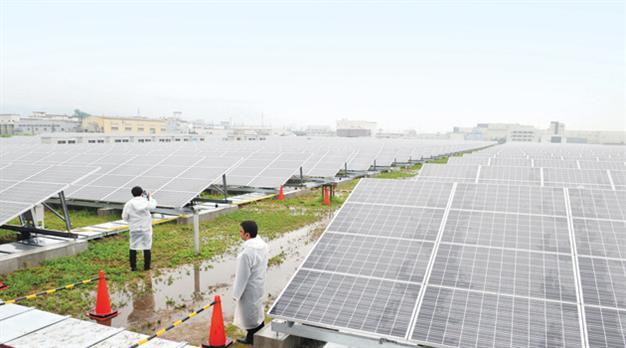North Africa, Europe to trade renewables
BRUSSELS/FRANKFURT - Reuters

Europe wants to expand its energy market into North Africa with an array giant solar plants like the one seen in this file photo. AFP photo
Germany’s decision to abandon nuclear energy and dwindling domestic subsidies for renewables have stoked a dazzlingly ambitious plan to expand Europe’s energy market into North Africa, with an array of giant solar and wind plants glinting in the desert sun.Desertec, a German consortium set up in 2009, envisages Europe will import up to a fifth of its electricity from solar and wind parks in North Africa and the Middle East by 2050.
Spread over 6,500 square miles - more than half the size of Belgium - Desertec’s projected delivery of 1,064 terawatt hours (TWh) would be almost enough energy to power the whole of Germany for two years.
With a projected budget of 400 billion euros ($492 billion), it has been dismissed as too expensive, too risky and too big. The upheaval of the Arab Spring, the revolutionary wave of popular protests and uprisings that began first in Tunisia in late 2010, has added to the doubts.
Business leaders say the economics are not compelling yet, but some say technological advances and judicious use of EU money could change that.
The European Commission, the EU’s executive arm, has raised the prospect of financial, legal and practical support.
“A vision can be more concrete than just a dream. It can be a political vision,” said Michael Koehler, head of cabinet in the EU’s Energy Commission. “Trade in renewables between Northern Africa and Europe is longer just a dream. It is declared EU policy.”
Massive national subsidies made cloudy Germany Europe’s biggest solar market. They are viewed as unsustainable and are expected to disappear when 52 gigawatts (GW) of solar capacity have been installed. It stands at 28 GW.
A possible beneficiary could be French consortium Medgrid, set up in 2010 to develop grids across North Africa and into Europe. Last year, it signed a cooperation deal with Desertec.
In the single energy market sought by the Commission, desert power could be dispersed widely, but Germany, the EU’s biggest economy and biggest energy user, is particularly in need.
Medgrid Chairman Andre Merlin said Germany offered “the most opportunities” for importing energy from the south, but the aim is for two-way traffic, with the EU also exporting any surplus.
Politically, the atmosphere is difficult, particularly in countries where rulers have been forced from power by civil uprisings, such as Tunisia and Libya.
Merlin predicts that will change.
“In Algeria and to some extent in Morocco, in these two countries our project can develop in the short term. Tunisia will come. Libya will come. We will see what will happen in the East,” he said.
The consortium, whose founders include power and grid firms Alstom, Areva, EDF and RTE, is looking at underwater connections through the Strait of Gibraltar and between Italy, Tunisia and Algeria via Sicily or Sardinia.
Between Turkey, Syria, Jordan and Egypt, the plan is for an overhead cable.
















